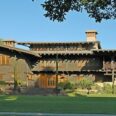
In 1923, Pasadena voters passed a bond measure to finance the construction of a civic center that was written into a larger blueprint for the city’s overall development known as the “Bennett Plan.”
Debate has arisen as to whether that visionary blueprint should be followed to the letter today or instead serve as a general guideline for more specific city development plans.
Nothing has spurred this debate more fiercely than the plans for a major hotel development in Pasadena’s Civic Center, directly across from Pasadena City Hall, which are now scheduled to come before the City Council on Monday, August 15.

The proposed hotel project involves the rehabilitation and adaptive reuse of the historically-significant YWCA building located at 78 N. Marengo Avenue, along with the addition of an 87,342-square-foot, six-story building attached and to the east, which together would become a 179-room Kimpton Hotel.
Opponents of the hotel project argue the project would violate the vision of the Bennett Plan, which the City recognizes in staff documents as an “important, lasting vision for … Pasadena.”
Edward Bennett’s influence on the urban landscape of Pasadena is indisputable.
In 2011, the American Planning Association/California Chapter (APA) awarded the Bennett Plan its California Planning Landmark Award. A year later the APA’s umbrella organization prized the plan with its national laurel as well.
Bennett was a protege of Daniel Burnham, a leading apostle of the “City Beautiful” movement.
City Beautiful was a reform wave of significant impact on the architectural and urban planning communities in the 1890s and 1900s. To oversimplify, it emphasized the aesthetics of cities as a way of improving quality of life and fostering civic virtue.
While the movement took root in a number of top-tier American cities, time and other trends tended to displace its influence. Pasadena, by contrast, is something of a City Beautiful jewel – a “fly in amber” – where the vision and ideas are particularly well-preserved.
With the construction of Pasadena Plaza the city, the APA said, “abandoned” Bennett’s scheme, only to rededicate itself to the document with a 1988 master plan that reinforced its influence and reversed some of the setbacks associated with the mall. The plan was backed by a $400 million investment.
Hence, the award and the uniquely public reputation enjoyed by the Bennett Plan among urban development schemes.
Hiring the firm of Bennett, Parsons and Frost was brainchild of his friend, astronomer George Ellery Hale whom, guided by the slogan, “to make a city beautiful is to make it prosperous,” envisioned Pasadena as the “Athens of the West.”
The debate now seems to revolve around the question of which Athens, that of 1923 or that of 2016?
While there is no shortage of parties in disagreement, a city review of the matter suggests the plan was intended more as a guideline than as a strict planning document from which there could be no variation.
In 2015, Kevin Johnson, project manager, Planning and Development Department, city of Pasadena, prepared a memorandum on the Bennett Plan for then City Manager Michael Beck.
Johnson said the memo’s purpose was to demonstrate that the plan was “intended as a general guideline for the future growth of the city.” He called the Bennett Plan a “visionary document” that has flourished in some aspects and languished in others.
“Useful in identifying ways to reinforce its vision,” said Johnson, the Bennett blueprint is nonetheless subject to more recent planning documents and zoning codes adopted by the city council.
Johnson’s memo seems to argue against suggestions that the Bennett plan cannot be undone without a reversal voted by the same community that approved it.
Johnson asserted that a more legalistic reading of the original ballot confirms that its reach is limited to the financing and structure of three civic center buildings and the creation of adjacent, axial boulevards, in pretty much those terms and without specific blueprints.
The Bennett Plan itself talks about the changing needs of a community: “The public building, like the church, has been submerged by the flood of great commercial structures, for the most part uncontrolled. In any logical plan provision should be made for the expansion of the public buildings to meet the growth and requirements of a community.”
At issue now, pointedly in reference to the proposed Kimpton hotel across from the Pasadena City Hall, is the extent to which the original Bennett Plan vision of the civic center should be strictly preserved or if the evolving needs of the city should be permitted to supersede.













 0 comments
0 comments


